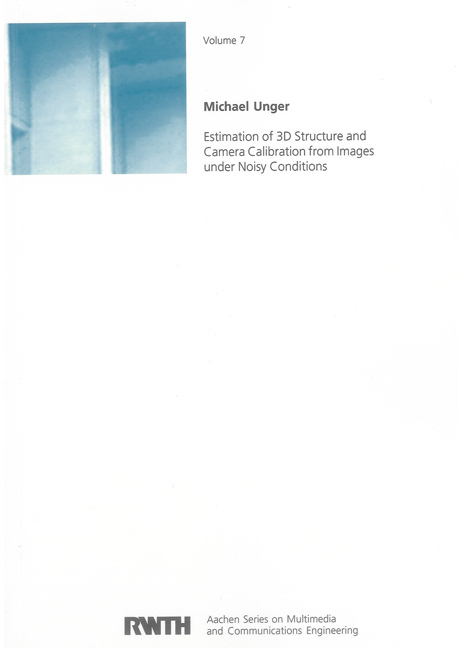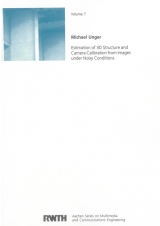Estimation of 3D Structure and Camera Calibration from Images under Noisy Conditions
Seiten
2011
|
1., Aufl.
Shaker (Verlag)
978-3-8440-0204-1 (ISBN)
Shaker (Verlag)
978-3-8440-0204-1 (ISBN)
- Keine Verlagsinformationen verfügbar
- Artikel merken
Extracting structural information from images or videos is the key to several technologies like 3-D television, driver assistance systems and surveillance applications. For an Euclidean 3-D reconstruction a dense motion field as well as the camera parameters have to be found.
The aim of this work is to automatically estimate point correspondences and camera parameters from a stereo image pair at the same time. For this purpose, camera calibration and stereo matching are combined within an iterative process. An important role is played by the epipolar geometry, which encapsulates several camera parameters and allows to reduce the search effort of a point correspondence analysis. As the epipolar geometry itself is determined from point correspondences, an important aspect in this area is still the treatment of noise and outliers. For this purpose a distance measure, based on the uncertainty of the epipolar geometry, is introduced. In addition, by exploiting constraints on the essential matrix, a polynomial method is derived to estimate the focal length.
In order to achieve a dense correspondence analysis, homographies are derived from point correspondences within regions defined by a color segmentation. In conjunction with a Delaunay triangulation, the homographies are used as predictors for further correspondence searches, leading to a dense motion estimation. Images pairs captured at different points in time may contain moving objects. Non static objects, having their own motion, do not obey to the epipolar constraint and are not able to contribute to a camera calibration. To cope with such objects, an enhanced framework for separating static and dynamic scene parts is presented.
The aim of this work is to automatically estimate point correspondences and camera parameters from a stereo image pair at the same time. For this purpose, camera calibration and stereo matching are combined within an iterative process. An important role is played by the epipolar geometry, which encapsulates several camera parameters and allows to reduce the search effort of a point correspondence analysis. As the epipolar geometry itself is determined from point correspondences, an important aspect in this area is still the treatment of noise and outliers. For this purpose a distance measure, based on the uncertainty of the epipolar geometry, is introduced. In addition, by exploiting constraints on the essential matrix, a polynomial method is derived to estimate the focal length.
In order to achieve a dense correspondence analysis, homographies are derived from point correspondences within regions defined by a color segmentation. In conjunction with a Delaunay triangulation, the homographies are used as predictors for further correspondence searches, leading to a dense motion estimation. Images pairs captured at different points in time may contain moving objects. Non static objects, having their own motion, do not obey to the epipolar constraint and are not able to contribute to a camera calibration. To cope with such objects, an enhanced framework for separating static and dynamic scene parts is presented.
| Reihe/Serie | Aachen Series on Multimedia and Communications Engineering ; 7 |
|---|---|
| Sprache | englisch |
| Maße | 148 x 210 mm |
| Gewicht | 255 g |
| Einbandart | Paperback |
| Themenwelt | Technik ► Elektrotechnik / Energietechnik |
| Schlagworte | 3-D Reconstruction • Background Subtraction • Camera Parameter Estimation • Fundamental Matrix • Point Correspondance Analysis |
| ISBN-10 | 3-8440-0204-9 / 3844002049 |
| ISBN-13 | 978-3-8440-0204-1 / 9783844002041 |
| Zustand | Neuware |
| Haben Sie eine Frage zum Produkt? |
Mehr entdecken
aus dem Bereich
aus dem Bereich
Wegweiser für Elektrofachkräfte
Buch | Hardcover (2024)
VDE VERLAG
CHF 67,20




